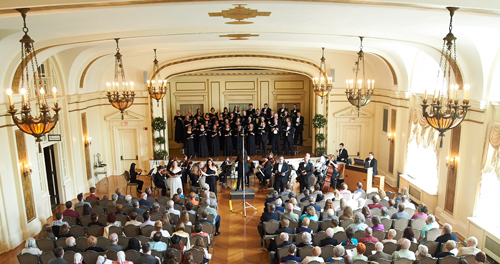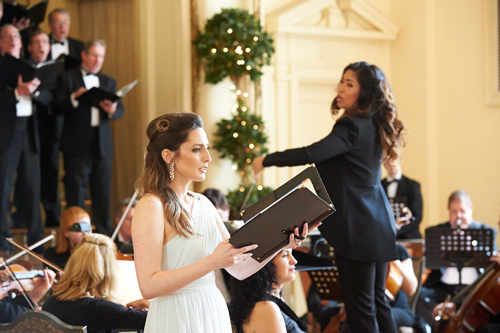by Daniel Hathaway
Guest conductor Marie Bucoy-Calavan led the well-prepared Summit Choral Society, four superb soloists, and an accomplished chamber orchestra drawn from the Akron Symphony in a spirited concert of works by Handel and Haydn on Sunday afternoon, April 12 at Greystone Hall in Akron. The venue, the performances and the weather combined to provide near-perfect conditions for the sold-out 60-minute concert — an entirely rewarding way to spend part of a weekend afternoon.
Bucoy-Calavan, now completing her first year as director of choral studies at the University of Akron, chose a winning selection of pieces to celebrate both the Summit Choral Society’s 25th Anniversary and the bicentennial of Boston’s Handel and Haydn Society, formed just half a dozen years after Haydn’s demise (and old enough to have commissioned a work from Beethoven, though that never materialized).
After a proclamation from the City of Akron was read by a city councilman with ties to the Society, the orchestra led off with Handel’s “The Arrival of the Queen of Sheba” from the oratorio Solomon. Probably no biblical character has ever enjoyed such ebullient entrance music. Rapid running passages in the violins and bubbly chains of thirds played by oboists Terry Orcutt and Cynthia Warren set the tone for a festive afternoon and revealed the responsive acoustics of the Greystone Hall ballroom.
California-based soprano Kerrie Caldwell made her first appearance of the afternoon in “With ravish’d ears” from Handel’s not-quite-an-oratorio, Alexander’s Feast. Singing with a clear, gem-like tone and applying vibrato only to the ends of long-held notes, Caldwell made a fine impression that presaged the soprano fireworks yet to come.
The Handel portion of the program culminated in one of the four anthems the composer wrote for the coronation of King George II and Queen Caroline in Westminster Abbey on October 11 of 1727. Let thy hand be strengthened falls into three parts: a quick opening chorus, a slower movement (“Let justice and judgment…”) and a concluding “Allelujah.”
Bucoy-Calavan set up a brisk tempo for the opening chorus and the singers’ first entrances were bright and clear. If the slow movement seemed overly-deliberate, it retained its solemn character until the final “Allelujah” closed out the work with strong and confident vocal and instrumental lines.
The chorus remained in place while the orchestra was reset for Haydn’s Missa in angustiis, (later known on questionable grounds as the “Lord Nelson” or “Coronation Mass”). The “in troubled times” subtitle referred both to the threats Napoleon’s army posed for Austria and the economic uncertainties of 1798, a development that forced Nikolaus II of Ezterhazy to dismiss his wind band, leaving Haydn with only strings, trumpets and timpani at his disposal when he wrote the Mass for his patron’s Name Day.
Set in the dark key of d-minor and lacking the bright colors of winds, the Mass is stark and forbidding in places — like the opening Kyrie with its thrilling but bone-chilling soprano solo, stunningly sung by Kerrie Caldwell. In other movements — the Gloria, the Credo and the concluding Dona nobis pacem — Haydn turns on the sunshine of D-Major in vigorous choral writing that includes some energetic fugues.
The Summit Choral Society’s 45 singers were completely responsive to Marie Bucoy-Calavan’s precise conducting, singing with fine intonation and vocal energy. The “Amen” of the “Credo,” one of the most elaborated passages in the Mass, was full of infectious spirit. The well-matched solo quartet (Caldwell, plus mezzo-soprano Olga Perez Flora, tenor James Flora, and baritone Brian Keith Johnson) distinguished themselves in the “Agnus Dei,” achieving an excellent blend of voices. Earlier, Johnson — who had sung some major solos with the Akron Symphony the evening before — delivered masterful, often high-lying solos in the “Gloria.”
At the end of such a well-wrought performance, it would have been splendid to have the solo quartet join the chorus for the “Dona nobis pacem.” The ovation from the audience might have been even warmer than it was for that extra icing on the cake.
Published on ClevelandClassical.com April 15, 2015.
Click here for a printable copy of this article








